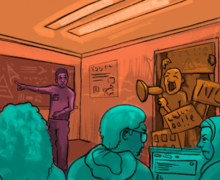Syracuse University professors awarded $330,000 to research bacteria
Alexandra Moreo | Photo Editor
Two Syracuse University professors in the College of Engineering and Computer Science are researching how antibiotic-resistant bacteria function.
Professors in Syracuse University’s College of Engineering and Computer Science were recently awarded a $330,000 grant to study the physiology of bacteria.
The grant’s funding became available in mid-July and will be available until June 2020, unless the professors apply for another grant to continue their research. The grant is funded by the National Science Foundation.
Dacheng Ren and Shikha Nangia, two professors in the department of biomedical and chemical engineering, are investigating the dormancy and resistance of bacteria.
“The area we’re targeting is mostly how to understand the dormancy of bacteria and how … that contributes to the big picture of drug resistance and big infections,” Ren said.
Once bacteria are dormant, in a state similar to hibernation, they are more difficult to kill. The two professors’ research uses synthetic biology, or the rewiring of cells, and a computer simulation to better understand interactions between antibodies and bacteria.
“What we provide in a simulation-computational world is the molecular level picture,” Nangia said. “So trying to understand questions like, ‘We observed this in an experiment, but why did that happen?’”
Their research will uncover more information about persister cells — subpopulations bacteria create that are particularly tolerant to antibiotics. Persister cells form when bacteria develop biofilm, a structure that coats the bacteria. This leads to complications in people with compromised immunity and chronic infections.
Discovering antibodies to kill the bacteria is the ultimate goal, but this research will help bridge a knowledge gap about persistence, according to the project abstract.
The study could make it easier for future research projects to create drugs that combat bacteria persistence.
“The last FDA-approved new class of antibodies was discovered in the late 1980s,” Ren said. “So, it’s been 30 years without a new class of antibodies.”
Antibiotic-resistant bacteria, known as superbugs, are becoming more common, Ren said. He researches the causes of bacterial dormancy and persistence.
“It is predicted if we don’t find the cure for (superbugs) by 2050, the superbug can kill more (people) than all cancers combined,” he said.
Nangia, using a computer, creates simulations based off Ren’s research. Using synthetic biology, she inputs antibody designs into the program. The computer demonstrates how antibodies communicate with bacteria.
The computation helps make predictions, said Ninad Patil, a graduate student assisting research efforts in Ren’s lab. It saves time and resources and provides a new perspective on information, Patil said.
There are about four students working on the project. Patil said it was a privilege helping contribute to the research.
“To leverage the talents on campus and find niches so that we can have synergy between different research groups, either in the same department or different departments or across colleges, I think that will help us do something bigger as individuals,” Ren said.
Published on November 14, 2017 at 12:03 am
Contact Catherine: ccleffer@syr.edu | @ccleffert





